Introduction:
In the age of constant connectivity and digital reliance, batteries serve as the unsung heroes that power our mobile devices. From smartphones to laptops, wearables, and electric vehicles, the importance of batteries in our daily lives cannot be overstated. In this article, we’ll explore the technology behind batteries, their evolution, and the challenges and innovations shaping the future of energy storage.
- The Basics: How Batteries Work:At its core, a battery is an electrochemical device that converts stored chemical energy into electrical energy. The two main components of a battery are the anode (negative electrode) and cathode (positive electrode), separated by an electrolyte. When a circuit is closed, a chemical reaction occurs, allowing electrons to flow from the anode to the cathode, creating an electrical current.
- Evolution of Battery Technology:a. Lead-Acid Batteries: Among the earliest and still widely used, lead-acid batteries power vehicles and uninterruptible power supply (UPS) systems.b. NiMH Batteries: Nickel-metal hydride batteries, used in early digital cameras and portable electronics, offered better energy density than their predecessors.c. Lithium-Ion Batteries: The game-changer in portable electronics, lithium-ion batteries provide high energy density, longer lifespan, and are lighter. They are the standard for smartphones, laptops, and electric vehicles.
- Challenges and Innovations:a. Capacity and Energy Density: Increasing demand for longer-lasting batteries with higher energy density remains a challenge. Researchers are exploring materials like lithium-sulfur and solid-state batteries to address these limitations.b. Charging Speed: Fast charging technology has become a focal point, with innovations like Qualcomm Quick Charge and USB Power Delivery enabling rapid replenishment of device power.c. Environmental Impact: The disposal of batteries poses environmental challenges. Research into sustainable materials and recycling programs aims to reduce the environmental footprint of battery production and disposal.
- Mobile Devices and Batteries:a. Smartphones: The quest for longer battery life in smartphones has led to optimizations in hardware, software, and the introduction of power-saving features.b. Laptops: The push for lightweight, portable laptops has driven advancements in battery technology to balance power and weight for enhanced mobility.c. Wearables: Miniaturized batteries power smartwatches and fitness trackers, emphasizing the importance of compact, efficient energy storage.
- Electric Vehicles (EVs) and Energy Storage:The shift towards electric vehicles has accelerated research into high-capacity batteries. Tesla’s Gigafactories and advancements in solid-state batteries aim to make EVs more accessible and efficient.
- Future Prospects:a. Solid-State Batteries: Promising increased safety, energy density, and faster charging, solid-state batteries are a focus of ongoing research and development.b. Wireless Charging: Eliminating the need for physical connectors, wireless charging technology continues to evolve, offering convenience and efficiency.
Conclusion:
Batteries are the lifeblood of our digital world, enabling the mobility and connectivity we often take for granted. As technology advances, the quest for more powerful, sustainable, and efficient energy storage solutions continues. Understanding the nuances of battery technology not only enhances our appreciation for the devices we use daily but also sheds light on the challenges and innovations shaping the future of energy storage.
